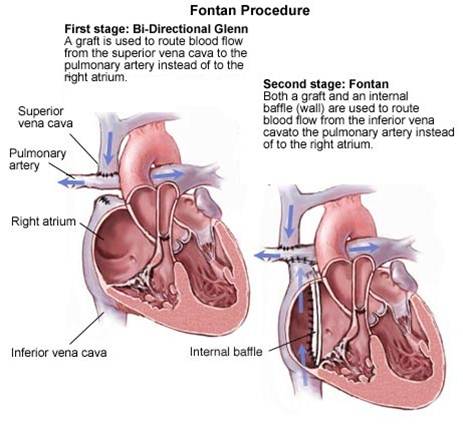Tricuspid atresia surgery: Difference between revisions
Jump to navigation
Jump to search
No edit summary |
No edit summary |
||
| Line 35: | Line 35: | ||
===ACC/AHA Guidelines - Recommendations for Surgery for Adults with Prior Fontan Repair (DO NOT EDIT)=== | ===ACC/AHA Guidelines - Recommendations for Surgery for Adults with Prior Fontan Repair (DO NOT EDIT)=== | ||
{|class="wikitable" | |||
|- | |||
| colspan="1" style="text-align:center; background:LightGreen"|[[ACC AHA guidelines classification scheme#Classification of Recommendations|Class I]] | |||
|- | |||
| bgcolor="LightGreen"|<nowiki>"</nowiki>'''1.'''Surgeons with training and expertise in CHD should perform operations on patients with prior Fontan repair for single-ventricle physiology.''([[ACC AHA guidelines classification scheme#Level of Evidence|Level of Evidence: C]])'' <nowiki>"</nowiki> | |||
|- | |||
| bgcolor="LightGreen"|<nowiki>"</nowiki>'''2.'''Reoperation after Fontan is indicated for the following:''([[ACC AHA guidelines classification scheme#Level of Evidence|Level of Evidence: C]])'' <nowiki>"</nowiki> | |||
|- | |||
| bgcolor="LightGreen"|<nowiki>"</nowiki>'''a.'''Unintended residual atrial septal defect (ASD) that results in right-to-left shunt with symptoms and/or cyanosis not amenable to transcatheter closure.''([[ACC AHA guidelines classification scheme#Level of Evidence|Level of Evidence: C]])'' <nowiki>"</nowiki> | |||
|- | |||
| bgcolor="LightGreen"|<nowiki>"</nowiki>'''b.'''Hemodynamically significant residual systemic artery-to-pulmonary artery shunt, residual surgical shunt, or residual ventricle-to-pulmonary artery connection not amenable to transcatheter closure.''([[ACC AHA guidelines classification scheme#Level of Evidence|Level of Evidence: C]])'' <nowiki>"</nowiki> | |||
|- | |||
| bgcolor="LightGreen"|<nowiki>"</nowiki>'''c.'''Moderate to severe systemic atrioventricular (AV) valve regurgitation.''([[ACC AHA guidelines classification scheme#Level of Evidence|Level of Evidence: C]])'' <nowiki>"</nowiki> | |||
|- | |||
| bgcolor="LightGreen"|<nowiki>"</nowiki>'''d.'''Significant (greater than 30-mm Hg peak-to-peak) subaortic obstruction.''([[ACC AHA guidelines classification scheme#Level of Evidence|Level of Evidence: C]])'' <nowiki>"</nowiki> | |||
|- | |||
| bgcolor="LightGreen"|<nowiki>"</nowiki>'''e.'''Fontan pathway obstruction.''([[ACC AHA guidelines classification scheme#Level of Evidence|Level of Evidence: C]])'' <nowiki>"</nowiki> | |||
|- | |||
| bgcolor="LightGreen"|<nowiki>"</nowiki>'''f.'''Development of venous collateral channels or pulmonary arteriovenous malformation not amenable to transcatheter management.''([[ACC AHA guidelines classification scheme#Level of Evidence|Level of Evidence: C]])'' <nowiki>"</nowiki> | |||
|- | |||
| bgcolor="LightGreen"|<nowiki>"</nowiki>'''g.'''Pulmonary venous obstruction.''([[ACC AHA guidelines classification scheme#Level of Evidence|Level of Evidence: C]])'' <nowiki>"</nowiki> | |||
|- | |||
| bgcolor="LightGreen"|<nowiki>"</nowiki>'''h.'''Rhythm abnormalities, such as complete AV block or sick sinus syndrome, that require epicardial pacemaker insertion.''([[ACC AHA guidelines classification scheme#Level of Evidence|Level of Evidence: C]])'' <nowiki>"</nowiki> | |||
|- | |||
| bgcolor="LightGreen"|<nowiki>"</nowiki>'''i.'''Creation or closure of a fenestration not amenable to transcatheter intervention.''([[ACC AHA guidelines classification scheme#Level of Evidence|Level of Evidence: C]])'' <nowiki>"</nowiki> | |||
|} | |||
===[[ACC AHA guidelines classification scheme#Classification of Recommendations|Class IIa]]=== | ===[[ACC AHA guidelines classification scheme#Classification of Recommendations|Class IIa]]=== | ||
Revision as of 14:24, 3 October 2012
|
Tricuspid atresia Microchapters |
|
Diagnosis |
|---|
|
Treatment |
|
Special Scenarios |
|
Case Studies |
|
Tricuspid atresia surgery On the Web |
|
American Roentgen Ray Society Images of Tricuspid atresia surgery |
|
Risk calculators and risk factors for Tricuspid atresia surgery |
Editor-In-Chief: C. Michael Gibson, M.S., M.D. [1]; Associate Editor-In-Chief: Keri Shafer, M.D. [2] Priyamvada Singh, MBBS [[3]]; Assistant Editor-In-Chief: Kristin Feeney, B.S. [[4]]
Overview
Surgery
ACC/AHA Guidelines - Recommendation for Surgical Options for Patients With Single Ventricle (DO NOT EDIT)
| Class I |
| "1.Surgeons with training and expertise in congenital heart disease (CHD) should perform operations for single-ventricle anatomy or physiology.(Level of Evidence: C) " |
Surgical Interventions
There are a number of interventional methods to address a tricuspid atresia. These include:
- PGE1 to maintain patent ductus arteriosus
- Modified Blalock-Taussig shunt to maintain pulmonary blood flow by placing a Gortex conduit between the subclavian artery and the pulmonary artery.
- Cavopulmonary anastomosis (hemi-Fontan or bidirectional Glenn) to provide stable pulmonary flow
- Fontan procedure to redirect inferior vena cava and hepatic vein flow into the pulmonary circulation

ACC/AHA Guidelines - Recommendation for Evaluation and Follow-Up After Fontan Procedure (DO NOT EDIT)
| Class I |
| "1.Lifelong follow-up is recommended for patients after a Fontan type of operation; this should include a yearly evaluation by a cardiologist with expertise in the care of adult congenital heart disease (ACHD) patients.(Level of Evidence: C) " |
ACC/AHA Guidelines - Recommendations for Surgery for Adults with Prior Fontan Repair (DO NOT EDIT)
| Class I |
| "1.Surgeons with training and expertise in CHD should perform operations on patients with prior Fontan repair for single-ventricle physiology.(Level of Evidence: C) " |
| "2.Reoperation after Fontan is indicated for the following:(Level of Evidence: C) " |
| "a.Unintended residual atrial septal defect (ASD) that results in right-to-left shunt with symptoms and/or cyanosis not amenable to transcatheter closure.(Level of Evidence: C) " |
| "b.Hemodynamically significant residual systemic artery-to-pulmonary artery shunt, residual surgical shunt, or residual ventricle-to-pulmonary artery connection not amenable to transcatheter closure.(Level of Evidence: C) " |
| "c.Moderate to severe systemic atrioventricular (AV) valve regurgitation.(Level of Evidence: C) " |
| "d.Significant (greater than 30-mm Hg peak-to-peak) subaortic obstruction.(Level of Evidence: C) " |
| "e.Fontan pathway obstruction.(Level of Evidence: C) " |
| "f.Development of venous collateral channels or pulmonary arteriovenous malformation not amenable to transcatheter management.(Level of Evidence: C) " |
| "g.Pulmonary venous obstruction.(Level of Evidence: C) " |
| "h.Rhythm abnormalities, such as complete AV block or sick sinus syndrome, that require epicardial pacemaker insertion.(Level of Evidence: C) " |
| "i.Creation or closure of a fenestration not amenable to transcatheter intervention.(Level of Evidence: C) " |
Class IIa
- Reoperation for Fontan conversion (i.e., revision of an atriopulmonary connection to an intracardiac lateral tunnel, intra-atrial conduit, or extracardiac conduit) can be useful for recurrent atrial fibrillation or flutter without hemodynamically significant anatomic abnormalities. A concomitant Maze procedure should also be performed. (Level of Evidence: C)
Class IIb
- Heart transplantation may be beneficial for severe SV dysfunction or protein-losing enteropathy (PLE). (Level of Evidence: C)}}